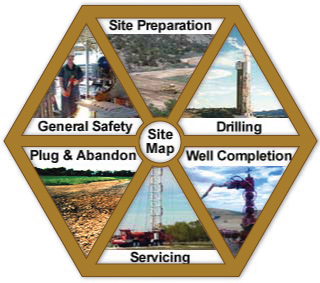
Oil and Gas Extraction
Over 450,000 workers were employed in the oil and gas extraction and support industries in 2011 (Quarterly Census of Employment and Wages). These workers are engaged in many different industrial processes needed to successfully drill and service a well. These processes frequently require the use of specialized equipment and specialized work crews.
From 2003 to 2010, 823 oil and gas extraction workers were killed on the job-a fatality rate seven times greater than the rate for all U.S. industries (Census of Fatal Occupational Injuries). This database also reports similar fatality rates since at least the early 1990s. Safety and health hazards and dangerous conditions that can result in fatalities for oil and gas workers include:
- Vehicle Accidents
- Struck-By/ Caught-In/ Caught-Between
- Explosions and Fires
- Falls
- Confined Spaces
- Chemical Exposures
The information and resources provided on this web page can help workers and employers identify and eliminate hazards in their workplace. The web page introduces applicable OSHA regulatory requirements, as well as industry standards and guidance aimed at identifying, preventing, and controlling exposure to hazards.
Employers must protect the safety and health of workers involved in oil and gas operations according to:
- OSHA's General Industry Standards (29 CFR 1910)
- OSHA's Construction Standards (29 CFR 1926)
- General Duty Clause of the Occupational Safety and Health (OSH) Act
Five OSHA regions located in areas of significant upstream activities use national, regional, and local emphasis programs to inspect oilfield worksites:
How do I find out about employer responsibilities and workers' rights?
Workers have a right to a safe workplace. The law requires employers to provide their employees with safe and healthful workplaces. The OSHA law also prohibits employers from retaliating against employees for exercising their rights under the law (including the right to raise a health and safety concern or report an injury). For more information see www.whistleblowers.gov or Workers' rights under the OSH Act.
OSHA can help answer questions or concerns from employers and workers. To reach your regional or area OSHA office, go to the OSHA Offices by State webpage or call 1-800-321-OSHA (6742).
Small businesses may contact OSHA's free On-site Consultation services funded by OSHA to help determine whether there are hazards at their worksites. To contact free consultation services, go to OSHA's On-site Consultation webpage or call 1-800-321-OSHA (6742) and press number 4.
Workers may file a complaint to have OSHA inspect their workplace if they believe that their employer is not following OSHA standards or that there are serious hazards. Workers can file a complaint with OSHA by calling 1-800-321-OSHA (6742), online via eComplaint Form, or by printing the complaint form and mailing or faxing it to the local OSHA area office. Complaints that are signed by a worker are more likely to result in an inspection.
If you think your job is unsafe or if you have questions, contact OSHA at 1-800-321-OSHA (6742). Your contact will be kept confidential. We can help. For other valuable worker protection information, such as Workers' Rights, Employer Responsibilities, and other services OSHA offers, visit OSHA's Workers' page.
Highlights
- NEW Health and Safety Risks for Workers Involved in Manual Tank Gauging and Sampling at Oil and Gas Extraction Sites*. NIOSH-OSHA Hazard Alert, (February 2016).
- Oil and Gas Well Drilling and Servicing. OSHA eTool. Contains an illustrated guide describing potential hazards and their possible solutions, developed jointly by OSHA and the industry.

- Worker Exposure to Silica During Hydraulic Fracturing. OSHA-NIOSH Hazard Alert, (June 2012). Describes silica hazards identified during NIOSH field studies, and provides information on identifying and controlling silica overexposure.
- Frequently Asked Questions about Silica and Hydraulic Fracturing. OSHA.
- Silica Exposure during Hydraulic Fracturing (PDF). OSHA InfoSheet (Publicaton 3622), (2012).
- Industry Profile: Oil and Gas Well Drilling and Servicing (PDF). OSHA. Provides information for SIC Code Industry Group 138 - Oil and Gas Field Services, including Bureau of Labor Statistics, top 10 cited standards, and potential industry hazards.
- OSHA Fatal Facts, Oil Patch
- Keeping Workers Safe During Oil Spill Response. For information on hazards and worker protection.
*Accessibility Assistance: Contact OSHA's Directorate of Technical Support and Emergency Management at (202) 693-2300 for assistance accessing PDF materials.
All other documents, that are not PDF materials or formatted for the web, are available as Microsoft Office® formats and videos and are noted accordingly. If additional assistance is needed with reading, reviewing or accessing these documents or any figures and illustrations, please also contact OSHA's Directorate of Technical Support and Emergency Management at (202) 693-2300.
**eBooks - EPUB is the most common format for e-Books. If you use a Sony Reader, a Nook, or an iPad you can download the EPUB file format. If you use a Kindle, you can download the MOBI file format.
Back to Top Translate
Translate